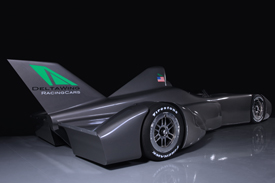The Delta Wing – Tail heavy can be a good thing
 |
| The Delta Wing car is tail heavy and should be tail happy |
Part 3 of 7 in our Delta Wing series addresses the weight distribution, which defies typical race car design convention.
This one will be short but sweet, but we wanted to give it a dedicated article because it is so key in tying the other characteristics of the car together.
This car has over 70% of its weight on the rear wheels.
This also goes back to the big wheel comparison we made before. If you recall, the seat of a big wheel basically put the weight of the rider right over (or very close to) the rear axle. This was also briefly mentioned in discussing how the car turns. Essentially this car is all about the rear wheels and the front end is just there to point it in the direction you want to go.
Also with so much weight over the rear wheels, the transfer of weight under various loads is greatly reduced, namely under heavy braking.
To us, the biggest benefit to this is 1) Having a lot of weight over the wheels that drive the car thereby increasing traction under heavy acceleration and deceleration, and 2) being able to brake and steer deep into a corner, otherwise known as trail braking.
When a driver is braking into a corner in a current type of IndyCar, with the more uniform weight distribution, a significant amount of weight transfers to the front wheels, which end up doing most of the braking and the steering, while the rear just follows behind. This is why you typically do not see much trail-braking in IndyCars as it is very easy to lock up the front wheels and push wide, effectively nullifying a pass attempt.
It would be ideal for a driver to be able to have the option and ability to carry the brakes deeper into the corner, thereby increasing passing opportunities, especially on a road course. This is key to increasing the competitive on-track product, but also adds an additional driving element and skill requirement.
In the Delta Wing configuration, the rear is doing most of the braking, allowing the front to do the steering work.
We could talk about the friction circle and vector addition, but that might get too cryptic.
Let's look at it like this. Let's say there is a number that represents the total amount of grip, and make that number 10. That grip can be all in one direction, forward or sideways, or a combination of the two that when added together, does not exceed 10. When you exceed 10, you lose grip and lock up a wheel. So let's say you want to brake as hard as possible, at 10, and then turn the wheel at maximum cornering speed, also 10. You add those two together and that is 20, which doesn't work.
Many of us have experienced this in the rain or snow when you go to hit the brakes and steer at the same time. The car just continues to go straight because you have used up all the grip in a straight line and there is none left to turn the car.
This is why almost all cars now have anti-lock brakes. It senses that limit of grip and comes off the brake for you just a bit, allowing you to steer the car and still brake at the highest possible level. Well, anti-lock brakes in a racing car are no fun, because it removes the skill of the driver.
So with this car, with the rear doing most of the braking work, we are not asking the front wheels to do two things, and the steering remains intact even at full braking.
With the majority of the weight on the rear wheels, the role of an active differential also becomes especially significant, and that will be in one of our other articles in the series, so keep checking back for more!
Note from the simulations above how the driver is able to control the heavy tail around Long Beach, including the hairpin
